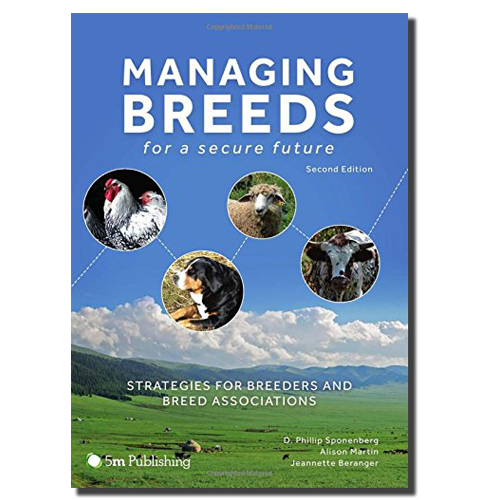Barbara Thiel graciously provided DWN's community with a book review - a great read for breed managers and breeders.
"Managing Breeds for a Secure Future: Strategies for Breeders and Breed Associations"
by D. Phillip Sponenberg, Jeannette Beranger and Alison Martin
Originally published in 2007, Second Edition 2017
 Book review
Book review
"Managing Breeds for a Secure Future: Strategies for Breeders and Breed Associations"
by D. Phillip Sponenberg, Jeannette Beranger and Alison Martin
"That is where breed politics get into the picture, and breed politics frequently do not have an answer in biology."
This quote sums up why "Managing Breeds" is so important. Talking to dog breeders about breed specific challenges concerning health and population genetics, you often encounter lack of understanding when you explain solutions based on (also in other kinds of livestock) proven breeding procedures and strategies.
The argumentation for this adverse attitude is often that we have pets, not livestock, so we may not use "those procedures" in dog breeding. In the course of trainings for new breeders, different breed-specific meetings and several private conversations it turns out that many members have a huge interest in population genetics, but the knowledge about it is sparse.
This is where the mentioned book could provide an excellent remedy.
"Managing breeds" starts with a clarification of terms, which you often hear in discussions about dog breeding, but which often seem to be not or not completely understood. What is a "breed", anyway? How do "landraces" differentiate from "standardised breeds", which both can be found in the world of purebred dogs? Which criteria could be used to in- / exclude single individuals in / from a breed population? What is a "breed standard", what are sensible quantifiable or qualitative characteristics, which could be preset and tested by a breed standard?
Anyone comparing the standards of different dog breeds will find significant differences regarding the clarity respectively the lack of clarity regarding the respective parameters depending on which breed is examined. The danger in which a too narrow breed standard could put the genetic diversity of a breed, is mentioned as well as the possible impact standard alterations in course of time may have.
The next chapter refers to the genealogical relationships in dog breeding: What is inbreeding, what is linebreeding? When do you speak about outcrossing, what is the difference between line-crossing and breed-crossing? How does the use of those breeding procedures influence the genetic diversity in a breed?
Armed with this refreshed basic knowledge we are now taken in medias res, namely to the potential strategies for population management. How can you control the level of inbreeding and the influence of single individuals on the whole population in order to achieve the highest possible benefit for the breed? Which opportunities and which risks offer the various means of assisted reproduction on behalf of population genetics?
The book continues with the management of inward and outward flow of genes in / out of populations. This topic is especially interesting for those dog breeds, where an influx of gene material via the registration of non-pedigree dogs is still possible.
After that some examples for specific kinds of livestock and different targets are given. Even if the chapter about dogs is quite short, you should not miss out on the presented breeding plans for other species. These are highly interesting, and broaden the view in any case.
Subsequently, procedures for the selection of breeding stock and strategic matings are discussed. In this context, the authors describe the use of estimated breeding values as tool to implement those measures.
The next chapter is dedicated to the opportunities cryopreservation provides for the maintenance of genetic diversity within a breed. Storage of frozen semen is only being used by a handful of breeders and stud dog owners at the moment. Maybe a data collection and coordination of those measures on a higher level should be given a second thought.
The book continues with the external influence on the development of breed populations. There, dog breeders will find quite familiar topics like supply and demand, legal conditions and the influence of imported animals.
The next two paragraphs refer to structures, rights and duties of breed associations. They should include not only the "administration" of the breed(s) under their care, but also research, recruitment of new breeders, education of their members and public relations activities for the respective breeds.
A further small chapter then explains different types of breed shows – maybe the reader will find suggestions for breed promoting events apart from the traditional dog shows.
The next topic is about the different possibilities for registration of breeding stock. Here not only the necessity of a purely quantitative registration of individuals is mentioned, but also the importance of controlling the development of single breeding lines within the population and the assessment of health data.
After this abundance of information the compilation would not be complete without the last chapter. This delves into the responsibility of every single breeder for "his" breed and the breeders’ community.
In that chapter we find the following quote, which will conclude the review:
"Breeders have responsibilities that go well beyond themselves. These include responsibilities to the breed and the genetic health, as well to the breeder community involved with it. Responsible producers leave the breed in better shape than they found it, while irresponsible individuals can do real and lasting damage."
I wish many breeders would read "Managing Breeds", and recommend it especially to those stakeholders who are entrusted with superordinate breeding decisions.
Greyhound specific book review link: http://katrin-und-joachim.de/2018/05/13/managing-breeds-for-a-secure-future-english-version/
![]()
 Donate
Donate
 Book review
Book review
Recommended Comments
Join the conversation
You can post now and register later. If you have an account, sign in now to post with your account.
Note: Your post will require moderator approval before it will be visible.